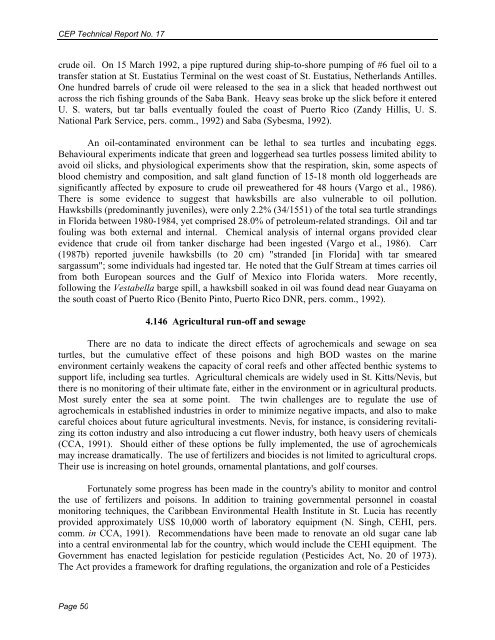Sea Turtle Recovery Action Plan for St. Kitts and Nevis - WIDECAST
Sea Turtle Recovery Action Plan for St. Kitts and Nevis - WIDECAST
Sea Turtle Recovery Action Plan for St. Kitts and Nevis - WIDECAST
You also want an ePaper? Increase the reach of your titles
YUMPU automatically turns print PDFs into web optimized ePapers that Google loves.
CEP Technical Report No. 17<br />
crude oil. On 15 March 1992, a pipe ruptured during ship-to-shore pumping of #6 fuel oil to a<br />
transfer station at <strong>St</strong>. Eustatius Terminal on the west coast of <strong>St</strong>. Eustatius, Netherl<strong>and</strong>s Antilles.<br />
One hundred barrels of crude oil were released to the sea in a slick that headed northwest out<br />
across the rich fishing grounds of the Saba Bank. Heavy seas broke up the slick be<strong>for</strong>e it entered<br />
U. S. waters, but tar balls eventually fouled the coast of Puerto Rico (Z<strong>and</strong>y Hillis, U. S.<br />
National Park Service, pers. comm., 1992) <strong>and</strong> Saba (Sybesma, 1992).<br />
An oil-contaminated environment can be lethal to sea turtles <strong>and</strong> incubating eggs.<br />
Behavioural experiments indicate that green <strong>and</strong> loggerhead sea turtles possess limited ability to<br />
avoid oil slicks, <strong>and</strong> physiological experiments show that the respiration, skin, some aspects of<br />
blood chemistry <strong>and</strong> composition, <strong>and</strong> salt gl<strong>and</strong> function of 15-18 month old loggerheads are<br />
significantly affected by exposure to crude oil preweathered <strong>for</strong> 48 hours (Vargo et al., 1986).<br />
There is some evidence to suggest that hawksbills are also vulnerable to oil pollution.<br />
Hawksbills (predominantly juveniles), were only 2.2% (34/1551) of the total sea turtle str<strong>and</strong>ings<br />
in Florida between 1980-1984, yet comprised 28.0% of petroleum-related str<strong>and</strong>ings. Oil <strong>and</strong> tar<br />
fouling was both external <strong>and</strong> internal. Chemical analysis of internal organs provided clear<br />
evidence that crude oil from tanker discharge had been ingested (Vargo et al., 1986). Carr<br />
(1987b) reported juvenile hawksbills (to 20 cm) "str<strong>and</strong>ed [in Florida] with tar smeared<br />
sargassum"; some individuals had ingested tar. He noted that the Gulf <strong>St</strong>ream at times carries oil<br />
from both European sources <strong>and</strong> the Gulf of Mexico into Florida waters. More recently,<br />
following the Vestabella barge spill, a hawksbill soaked in oil was found dead near Guayama on<br />
the south coast of Puerto Rico (Benito Pinto, Puerto Rico DNR, pers. comm., 1992).<br />
4.146 Agricultural run-off <strong>and</strong> sewage<br />
There are no data to indicate the direct effects of agrochemicals <strong>and</strong> sewage on sea<br />
turtles, but the cumulative effect of these poisons <strong>and</strong> high BOD wastes on the marine<br />
environment certainly weakens the capacity of coral reefs <strong>and</strong> other affected benthic systems to<br />
support life, including sea turtles. Agricultural chemicals are widely used in <strong>St</strong>. <strong>Kitts</strong>/<strong>Nevis</strong>, but<br />
there is no monitoring of their ultimate fate, either in the environment or in agricultural products.<br />
Most surely enter the sea at some point. The twin challenges are to regulate the use of<br />
agrochemicals in established industries in order to minimize negative impacts, <strong>and</strong> also to make<br />
careful choices about future agricultural investments. <strong>Nevis</strong>, <strong>for</strong> instance, is considering revitalizing<br />
its cotton industry <strong>and</strong> also introducing a cut flower industry, both heavy users of chemicals<br />
(CCA, 1991). Should either of these options be fully implemented, the use of agrochemicals<br />
may increase dramatically. The use of fertilizers <strong>and</strong> biocides is not limited to agricultural crops.<br />
Their use is increasing on hotel grounds, ornamental plantations, <strong>and</strong> golf courses.<br />
Fortunately some progress has been made in the country's ability to monitor <strong>and</strong> control<br />
the use of fertilizers <strong>and</strong> poisons. In addition to training governmental personnel in coastal<br />
monitoring techniques, the Caribbean Environmental Health Institute in <strong>St</strong>. Lucia has recently<br />
provided approximately US$ 10,000 worth of laboratory equipment (N. Singh, CEHI, pers.<br />
comm. in CCA, 1991). Recommendations have been made to renovate an old sugar cane lab<br />
into a central environmental lab <strong>for</strong> the country, which would include the CEHI equipment. The<br />
Government has enacted legislation <strong>for</strong> pesticide regulation (Pesticides Act, No. 20 of 1973).<br />
The Act provides a framework <strong>for</strong> drafting regulations, the organization <strong>and</strong> role of a Pesticides<br />
Page 50
















